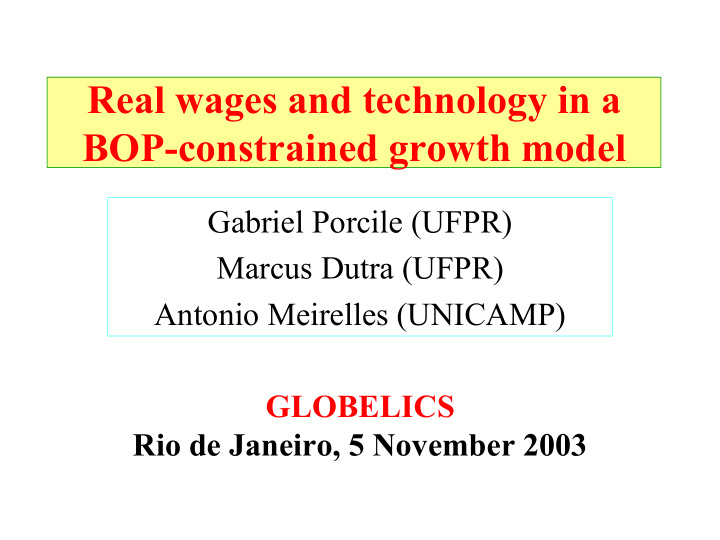



Real wages and technology in a BOP-constrained growth model Gabriel Porcile (UFPR) Marcus Dutra (UFPR) Antonio Meirelles (UNICAMP) GLOBELICS Rio de Janeiro, 5 November 2003
Real wages and growth • Kaleckian models suggest that in a closed economy higher real wages favor growth by increasing the utilization rate of capital and the investment rate (Dutt, 1984) • In an open economy, Blecker (1989) shows a positive effect of higher real wages on growth if a) firms reduce their target mark-up, b) the income elasticity of imports is low and c) the price elasticities of imports and exports are high • Blecker´s results require to remove PPP so that a lower mark-up raises price competitiveness
Real wages, growth and learning • This model suggests another mechanism by which higher real wages could stimulate growth in an open economy • To the extent that higher real wages stimulate learning and create a more favorable environment for economic, technological and institutional change, then they will favor non-price international competitiveness too. • This in turn will lead to a higher rate of growth consistent with BOP equilibrium (Cimoli, 1988; Verspagen, 1993; McCombie and Thirwall, 1994)
Real wages and learning • Bliss and Stern (1978) and Bassu (1984): productivity is a function of workers´ consumption (especially at low levels of development) • Stiglitz and Shapiro (1989) and Ros (2000): effort at work is higher when real wages are higher (efficiency wages) • Ranis and Stewart (2002): higher human development leads to more learning and higher productivity growth • Fajnzylber (1990): a more egalitarian society offers less resistance to economic and institutional change
Demand equations: prices, income and the quality index P * ψ Y = π M A ( E ) P P η ε λ = Ω X B ( ) Z P * E = EP * M PX Conventional demand functions, except for the quality index (Amable, 1994)
Rate of growth consistent with BOP equilibrium and the evolution of the quality index 1 = η + ψ + − − + ε + λω y (( 1 )( p p * e ) z ) π T ω = = S S T N Critical assumption: the rate of change of the quality index is a function of the technology gap (Verspagen, 1993)
Motion equations: real wages • The rate of growth of the real wage: • 1) increases with the inverse of the technology gap (a higher rate of growth implies a higher rate of labor demand) • 2) falls with the level of the real wage (increasing resistance of capitalists to give in to labor demands)
Motion equations: the inverse of the technology gap • The rate of change of the inverse of the technology gap: • Increases with the real wage, up to a certain critical real wage level, Wc • Falls with the inverse of the technology gap (decreasing technological spill-over from the North) (Fagerberg, 1988)
Real wages and the technology gap: motion equations = − + w b b W b S 0 1 2 = + − ≤ s a a W a S para W Wc 0 1 2 = + − > s a a Wc a S para W Wc 0 1 2
Complementary growth and real wages • There are two possible equilibria • The first one (W < Wc) is inefficient as it implies both a lower rate of growth and lower real wages • This equilibrium does not fully exploit the scope for a positive feed-back between (complementary) growth and real wages
Growth and real wages no longer complementary • Te second equilibrium (W > Wc) implies that a policy aimed at improving income distribution will no longer foster learning • Policies aimed at increasing the rate of imitation (lowering the coefficient a2 ) will lead to higher real wages in equilibrium • Policies aimed at increasing the rate of learning by workers (higher b2) will lead to higher real wages in equilibrium • The higher Wc, the higher will be the rate of growth and the real wages of the Southern economy
Wc: a moving target • When Wc is high there will be more room for a virtuous circle between growth and real wages • Wc is a moving target: as the economy achieves a higher degree of diversification and technological complexity, there will be more opportunities for learning when the real wages increase.
Conclusions • 1. Higher real wages encourage learning up to a certain critical real wage Wc • 2. An economy will be trapped in a inefficient equilibrium if W* < Wc. In this case, policies aimed at increasing real wages and labor welfare will foster growth as well • 4. If W* > Wc, policies aimed at encouraging technological diffusion and workers´ capabilities will lead to higher growth and real wages • A higher Wc implies higher growth and higher real wages in equilibrium • 5. Wc is a moving target that increases as the economy diversifies
Recommend
More recommend